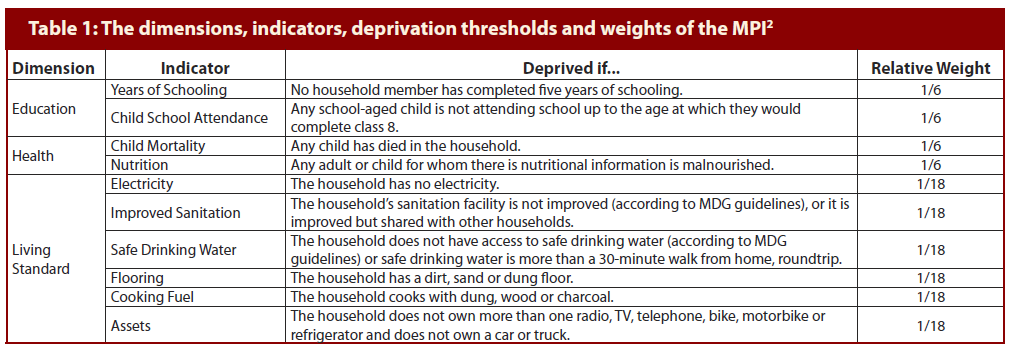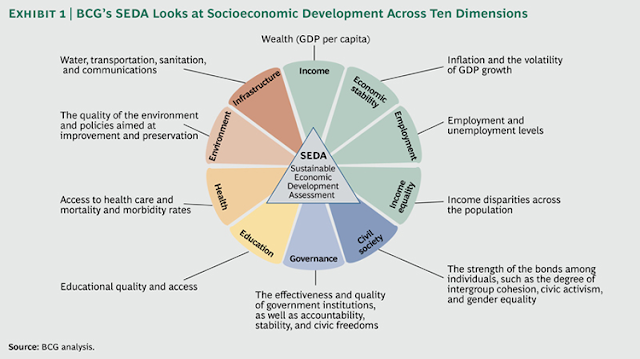PakAlumni Worldwide: The Global Social Network
The Global Social Network
Pakistan Translates GDP Growth to Citizens' Welfare Better Than India
One particular metric BCG uses is growth-to-well-being coefficient on which Pakistan scores 0.87, higher than India's 0.77 and China's 0.75. Among South Asian nations, Bangladesh scores much higher at 1.03. The top ten countries in “current well-being” remain in Western Europe.
The BCG report quotes American economist Simon Kuznets, the creator of the concept of GDP in 1934, who said: "The welfare of a nation can scarcely be inferred from measurement of national income". It uses SEDA (sustainable economic development assessment) to score and rank countries.
The report uses 5 years worth of GDP growth data up to 2014 and compares it with improvements in citizens' well-being in the same period.
On the question of the ability to translate GDP growth to citizens' well-being, Colin Hunter, Center for Research on Globalization, has written the following:
"India is home to over 340 million destitute people and is the second poorest country in South Asia after war-torn Afghanistan...In South Asia, Afghanistan has the highest level of destitution at 38%. This is followed by India at 28.5%. Bangladesh (17.2%) and Pakistan (20.7%) have much lower levels"
GDP growth and increases in per capita income and human development index are often used as indicators to represent improvements in the lives of ordinary people in developing nations in Asia, Africa and Latin America. Both of these have significant limitations which are addressed by Oxford Poverty and Human Development Initiative (OPHI)'s MPI, multi-dimensional poverty index.
The MPI brings together 10 indicators, with equal weighting for education, health and living standards (see table). If you tick a third or more of the boxes, you are counted as poor.
 |
| Source: Oxford Poverty and Human Development Initiative |
Eradicating poverty in South Asia requires every person having access to safe drinking water, sanitation, housing, nutrition, health and education.
According to the MPI, out of its 1.2 billion-plus population, India alone is home to over 340 million destitute people and is the second poorest country in South Asia after war-torn Afghanistan, according to Colin Hunter of Canada-based Global Research.
Some 640 million poor people live in India (40% of the world’s poor), mostly in rural areas, meaning an individual is deprived in one-third or more of the ten indicators mentioned above (malnutrition, child deaths, defecating in the open).
In South Asia, Afghanistan has the highest level of destitution at 38%. This is followed by India at 28.5%. Bangladesh and Pakistan have much lower levels. The study placed Afghanistan as the poorest country in South Asia, followed by India, Bangladesh, Pakistan and Nepal, according to Hunter.
Afghanistan is the poorest country in South Asia in terms of multi-dimensional poverty with 66% of its people being poor, followed by India with 54%, Bangladesh with 51%, Pakistan and Nepal at 44%, Bhutan at 27%, and Sri Lanka and the Maldives at 5%, according to Oxford researchers. Among 104 countries ranked by OPHI, Nepal ranks 82, India 74, Bangladesh 73, Pakistan 70, Sri Lanka 32 in MPI poverty.
Why has India lagged behind its neighbors in spite of rapid economic growth in recent years? Here's how Hunter explains it: "The ratio between the top and bottom 10% of wage distribution has doubled since the early 1990s, when India opened up it economy. According to the 2011 Organization for Cooperation and Economic Development report ‘Divided we stand’, this has made India one of the worst performers in the category of emerging economies. The poverty alleviation rate is no higher than it was 25 years ago. Up to 300,000 farmers have committed suicide since 1997 due to economic distress and many more have quit farming."
What Colin Hunter hasn't clearly articulated is the fact that India remains home to the world's largest population of poor, hungry and illiterates who lack even basic sanitation 67 years after the nation's independence from British colonial rule.
As the new Hindu Nationalist government under Narendra Modi begins its anti-Muslim and anti-Pakistan campaigns so soon after inauguration, an Indian journalist Pankaj Mishra reminds Indians in a recent New York Times Op Ed that that "India’s reputation as a “golden bird” flourished during the long centuries when it was allegedly enslaved by Muslims. A range of esteemed scholars — from Sheldon Pollock to Jonardon Ganeri — have demonstrated beyond doubt that this period before British rule witnessed some of the greatest achievements in Indian philosophy, literature, music, painting and architecture".
It's time for Mr. Modi to shun his bellicose rhetoric (boli nahee goli--India's guns will do the talking) against Pakistan and focus on much more important issues of deep deprivation of his people.
Here's a video on Grinding Poverty in Resurgent India:
Haq's Musings Grinding Poverty in Resurgent India by faizanmaqsood1010
http://youtu.be/84-Qz4vFVHs
Related Links:
Haq's Musings
Pakistan Sees Robust Growth in Energy, Autos, Cement and Steel
Depth of Deprivation in India
India Home to World's Largest Population of Poor, Hungry and Illite...
Grinding Poverty in Resurgent India
An Indian Farmer Commits Suicide Every 30 Minutes
India's Israel Envy: What if Modi Attacks Pakistan?
India Teaching Young Students Akhand Bharat
Pakistan Army at the Gates of Delhi
-
Comment by Riaz Haq on July 31, 2016 at 6:48pm
-
#BMI Research puts #Pakistan in top "10 emerging markets". Key Growth Drivers: #Auto & #Textiles #Manufacturing Hub http://read.bi/29mmYQT
"Pakistan will develop as manufacturing hub over the coming years, with the textile and automotive sectors posting the fastest growth at the beginning of our forecast period. Domestic manufacturing investment will be boosted by the windfall from lower energy prices compared to the last decade, and improved domestic energy supply."
A new report from BMI Research has identified the "10 emerging markets of the future" — the countries that are set to become new drivers of economic growth over the next 10 years.
BMI estimates that these countries will cumulatively add $4.3 trillion to global GDP by 2025 — roughly the equivalent of Japan's current economy.
In general, manufacturing and construction are the sectors that will drive the economies. BMI reports that new manufacturing hubs are set to emerge in Bangladesh, Myanmar, and Pakistan, and that these countries will see particularly strong growth in exporting manufacturing industries. And construction growth is going to be widespread throughout all the countries — partly to facilitate increases in urban populations and partly to help develop the manufacturing sector.
On the other hand, extractive industries — like mining, oil, and gas — are going to play a far smaller role in driving growth than they have the past 15 years.
While it might provide bright spots for some countries, the report states, "the ubiquitous commodity-driven growth model that was derailed by the 2012-2015 collapse in commodity prices is not coming back."
Comment
Twitter Feed
Live Traffic Feed
Sponsored Links
South Asia Investor Review
Investor Information Blog
Haq's Musings
Riaz Haq's Current Affairs Blog
Please Bookmark This Page!
Blog Posts
Pakistan Household Survey HIES 2024-25 Raises More Questions Than It Answers
Recently released HIES 2024-25 household integrated economic survey by Pakistan Bureau of Statistics (PBS) raises more questions than it answers. For example, it shows that Pakistani households are buying lower amounts of basic food ingredients like wheat, meat and eggs in the last four years, implying that people are eating less to cover other expenses, like electricity and gas. But it doesn't explain why the households have reported significantly lower purchases of these items than…
ContinuePosted by Riaz Haq on January 6, 2026 at 5:00pm
Happy New Year 2026: Pakistan's Year 2025 in Review
As we enter the year 2026, it is time to review the year 2025 and wish you all Happy New Year 2026! May it bring peace, prosperity and happiness to all!!
The year 2025 saw Pakistan defeat a brazen Indian attack on its soil, while reviving its economy and…
ContinuePosted by Riaz Haq on December 30, 2025 at 9:30pm — 7 Comments
© 2026 Created by Riaz Haq.
Powered by
![]()


You need to be a member of PakAlumni Worldwide: The Global Social Network to add comments!
Join PakAlumni Worldwide: The Global Social Network